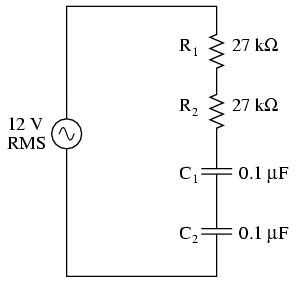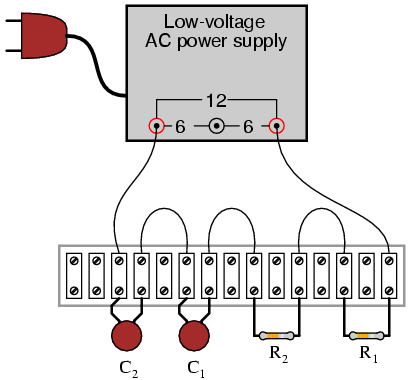Phase shift
PARTS AND MATERIALS
-
Low-voltage AC power supply
-
Two capacitors, 0.1 �F each, non-polarized
(Radio Shack catalog # 272-135)
-
Two 27 kΩ resistors
I recommend ceramic disk capacitors, because
they are insensitive to polarity (non-polarized),
inexpensive, and durable. Avoid capacitors with any kind of
polarity marking, as these will be destroyed when powered by
AC!
CROSS-REFERENCES
Lessons In Electric Circuits, Volume
2, chapter 1: "Basic AC Theory"
Lessons In Electric Circuits, Volume
2, chapter 4: "Reactance and Impedance -- Capacitive"
LEARNING OBJECTIVES
SCHEMATIC DIAGRAM

ILLUSTRATION

INSTRUCTIONS
Build the circuit and measure voltage drops
across each component with an AC voltmeter. Measure total
(supply) voltage with the same voltmeter. You will discover
that the voltage drops do not add up to equal the
total voltage. This is due to phase shifts in the circuit:
voltage dropped across the capacitors is out-of-phase with
voltage dropped across the resistors, and thus the voltage
drop figures do not add up as one might expect. Taking phase
angle into consideration, they do add up to equal the
total, but a voltmeter doesn't provide phase angle
measurements, only amplitude.
Try measuring voltage dropped across both
resistors at once. This voltage drop will equal the
sum of the voltage drops measured across each resistor
separately. This tells you that both the resistors' voltage
drop waveforms are in-phase with each other, since they add
simply and directly.
Measure voltage dropped across both
capacitors at once. This voltage drop, like the drop
measured across the two resistors, will equal the sum
of the voltage drops measured across each capacitor
separately. Likewise, this tells you that both the
capacitors' voltage drop waveforms are in-phase with each
other.
Given that the power supply frequency is 60
Hz (household power frequency in the United States),
calculate impedances for all components and determine all
voltage drops using Ohm's Law (E=IZ ; I=E/Z ; Z=E/I). The
polar magnitudes of the results should closely agree with
your voltmeter readings.
COMPUTER SIMULATION
Schematic with SPICE node numbers:

The two large-value resistors Rbogus1
and Rbogus1 are connected across the capacitors
to provide a DC path to ground in order that SPICE will
work. This is a "fix" for one of SPICE's quirks, to avoid it
from seeing the capacitors as open circuits in its analysis.
These two resistors are entirely unnecessary in the real
circuit.
Netlist (make a text file containing the
following text, verbatim):
phase shift
v1 1 0 ac 12 sin
r1 1 2 27k
r2 2 3 27k
c1 3 4 0.1u
c2 4 0 0.1u
rbogus1 3 4 1e9
rbogus2 4 0 1e9
.ac lin 1 60 60
* Voltage across each component:
.print ac v(1,2) v(2,3) v(3,4) v(4,0)
* Voltage across pairs of similar components
.print ac v(1,3) v(3,0)
.end
|